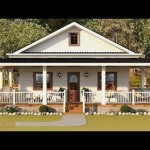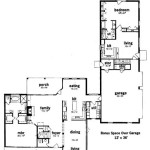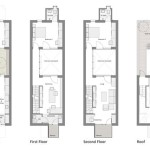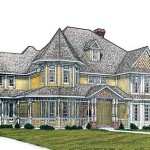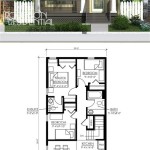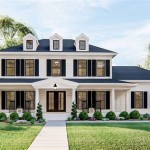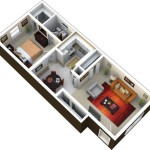A Split Floor Plan House is designed with strategically positioned public and private spaces. The fundamental purpose of a split floor plan is to separate the sleeping quarters in the house from the social areas, which are typically the living room, dining room, and kitchen. One exemplary application is positioning the master suite on one side of the house, while the remaining bedrooms are located on the opposite side. This configuration fosters privacy for the primary occupants of the house and their guests.
Split floor plan houses offer numerous advantages. The most notable benefit is enhanced privacy for the occupants, as it minimizes noise and disturbance between the sleeping and social areas. Additionally, it provides a sense of sanctuary for the primary occupants by separating their private space from the rest of the house.
In the following sections, we will delve deeper into the various aspects of split floor plan houses, exploring their advantages and disadvantages, design considerations, and current trends in this architectural style.
Split floor plan houses offer a range of advantages, including:
- Enhanced privacy
- Separation of public and private spaces
- Noise reduction
- Improved security
- Increased flexibility
- Better traffic flow
- Enhanced curb appeal
- Potential for energy savings
- Customization options
However, it is important to note that split floor plan houses may also have some drawbacks, such as:
Enhanced privacy
Split floor plan houses offer enhanced privacy for the occupants, particularly for the primary occupants of the house. This is achieved by physically separating the sleeping quarters from the social areas, which are typically the living room, dining room, and kitchen.
The master suite, which is typically located on one side of the house, serves as a private sanctuary for the primary occupants. It is separated from the other bedrooms, which are usually situated on the opposite side of the house, providing a sense of seclusion and tranquility.
This separation minimizes noise and disturbance between the sleeping and social areas. For example, if guests are entertaining in the living room, their noise and conversations will be less likely to disrupt the occupants resting in the bedrooms.
Furthermore, split floor plan houses can provide enhanced privacy for guests staying in the house. By separating the guest room from the primary occupants’ bedrooms, guests can have their own private space without feeling like they are intruding on the hosts’ privacy.
Separation of public and private spaces
Split floor plan houses offer a clear separation between public and private spaces, creating distinct zones for different activities and levels of privacy.
- Public spaces, such as the living room, dining room, and kitchen, are typically located in the front of the house and are designed for entertaining guests and socializing.
- Private spaces, such as the bedrooms and bathrooms, are usually situated in the back of the house and are for rest and relaxation.
- Semi-public spaces, such as the home office or den, can be positioned in a transition zone between the public and private areas. These spaces can serve multiple purposes and provide flexibility in how the house is used.
- Circulation spaces, such as hallways and staircases, are designed to connect the different areas of the house while maintaining the separation between public and private spaces.
This separation of spaces allows for more flexibility in the use of the house and provides a sense of privacy for the occupants. For example, family members can entertain guests in the public areas without disturbing those resting in the private areas.
Noise reduction
Split floor plan houses offer significant advantages in terms of noise reduction, creating a more peaceful and tranquil living environment.
One of the primary ways in which split floor plan houses reduce noise is by physically separating the sleeping quarters from the social areas. This separation minimizes the transmission of noise between these two zones. For example, if guests are entertaining in the living room, their noise and conversations will be less likely to disturb occupants resting in the bedrooms.
Additionally, split floor plan houses often incorporate design elements that further enhance noise reduction. For instance, soundproof insulation can be installed in the walls and ceilings between the sleeping and social areas, effectively blocking out noise. Carpeting and rugs can also be used to absorb sound, reducing noise levels throughout the house.
Furthermore, split floor plan houses typically have well-defined circulation spaces, such as hallways and staircases, which help to contain noise within specific areas. This prevents noise from spreading throughout the entire house and ensures that private spaces remain peaceful and quiet.
Overall, the combination of physical separation, soundproofing materials, and well-designed circulation spaces makes split floor plan houses ideal for individuals who value peace and tranquility in their living environment.
Improved security
Split floor plan houses offer enhanced security features compared to traditional floor plans due to the physical separation of the sleeping quarters from the social areas. This separation creates multiple layers of defense against potential intruders.
In a split floor plan house, the bedrooms are typically positioned on one side of the house, while the social areas, such as the living room, dining room, and kitchen, are situated on the opposite side. This separation creates a natural barrier that makes it more difficult for intruders to access the sleeping quarters, where occupants are most vulnerable.
Furthermore, split floor plan houses often incorporate security features such as security systems, motion sensors, and reinforced doors and windows. These features work in conjunction with the physical separation to provide multiple layers of protection against unauthorized entry.
Additionally, the separation of spaces in a split floor plan house allows for better monitoring and control of access to different areas of the house. For example, family members can restrict access to the sleeping quarters at night, creating a more secure environment for rest and relaxation.
Overall, the combination of physical separation and enhanced security features makes split floor plan houses an ideal choice for individuals who prioritize the safety and security of their homes and families.
Increased flexibility
Split floor plan houses offer increased flexibility in terms of space utilization and design compared to traditional floor plans. This flexibility stems from the separation of the sleeping quarters from the social areas, which allows for a variety of configurations and options.
- Adaptability to different lifestyles
Split floor plan houses can be easily adapted to suit different lifestyles and family dynamics. For instance, a family with young children may choose to have the children’s bedrooms on the same side of the house as the master suite for convenience and supervision. Alternatively, a couple without children may opt for a more open floor plan with the master suite on one side and a guest room or home office on the other side.
- Multi-generational living
Split floor plan houses are well-suited for multi-generational living situations, as they provide separate and private spaces for different generations. For example, the master suite can be located on one side of the house, while the other bedrooms can be situated on the opposite side, providing privacy for both the older and younger generations.
- Future expansion
Split floor plan houses offer flexibility for future expansion, as they can be easily modified to accommodate changing needs. For instance, if a family expands, additional bedrooms or a home office can be added to the side of the house where the secondary bedrooms are located. This flexibility ensures that the house can adapt to the evolving needs of the occupants over time.
- Customization options
Split floor plan houses provide ample opportunities for customization, allowing homeowners to tailor the design to their specific preferences and requirements. For example, the size and layout of the bedrooms, bathrooms, and social areas can be adjusted to suit the needs of the occupants. Additionally, the separation of spaces allows for greater flexibility in terms of interior design, as different styles and themes can be applied to different areas of the house.
Overall, the increased flexibility offered by split floor plan houses makes them a popular choice for homeowners who value adaptability, customization, and future-proofing their homes.
Better traffic flow
Split floor plan houses are designed to optimize traffic flow and create a more efficient and comfortable living environment. The separation of the sleeping quarters from the social areas allows for a logical and organized arrangement of spaces, which reduces congestion and improves overall functionality.
- Separation of public and private spaces
The split floor plan design clearly delineates public and private spaces, ensuring that the flow of traffic between these areas is smooth and efficient. For instance, guests can easily access the living room, dining room, and kitchen without having to navigate through private areas such as bedrooms and bathrooms.
- Defined circulation spaces
Split floor plan houses often incorporate well-defined circulation spaces, such as hallways and staircases, which guide traffic flow and prevent congestion. These spaces are designed to be wide enough to accommodate multiple people moving around comfortably, reducing the likelihood of bottlenecks and accidents.
- Minimized noise and disturbance
The separation of sleeping quarters from social areas not only enhances privacy but also minimizes noise and disturbance. This is especially beneficial for families with young children or shift workers who need a quiet environment for rest and relaxation.
- Improved accessibility
Split floor plan houses can be designed to provide improved accessibility for individuals with mobility impairments. For example, the master suite can be located on the first floor, eliminating the need for stairs, and wider doorways and hallways can be incorporated throughout the house to accommodate wheelchairs and other mobility aids.
Overall, the thoughtful design of split floor plan houses results in better traffic flow, improved functionality, and a more comfortable living environment for occupants.
Enhanced curb appeal
Split floor plan houses offer enhanced curb appeal due to their balanced and symmetrical design. The separation of the sleeping quarters from the social areas creates a visually pleasing facade that is both attractive and inviting.
- Balanced proportions
Split floor plan houses typically have a well-proportioned facade, with the sleeping quarters and social areas forming distinct wings that are balanced around a central axis. This symmetry creates a sense of harmony and order, which is aesthetically appealing to the eye.
- Varied rooflines
The separation of spaces in a split floor plan house often results in varied rooflines, which add visual interest and depth to the facade. For example, the sleeping quarters may have a gable roof, while the social areas may have a hip roof. This variation in rooflines creates a dynamic and visually appealing exterior.
- Architectural details
Split floor plan houses often incorporate architectural details that enhance their curb appeal. These details may include decorative moldings, columns, shutters, and window treatments. These elements add character and sophistication to the facade, making the house stand out from its surroundings.
- Landscaping
The separation of spaces in a split floor plan house also allows for more flexibility in landscaping. For example, the front yard can be designed to complement the sleeping quarters, while the backyard can be designed to complement the social areas. This flexibility allows homeowners to create a cohesive and visually appealing outdoor space that enhances the overall curb appeal of the house.
Overall, the combination of balanced proportions, varied rooflines, architectural details, and landscaping options makes split floor plan houses highly attractive and desirable from a curb appeal perspective.
Potential for energy savings
Split floor plan houses offer significant potential for energy savings due to the separation of the sleeping quarters from the social areas. This separation allows for more efficient heating and cooling, as well as reduced energy consumption for lighting and appliances.
- Zoned heating and cooling
In a split floor plan house, the heating and cooling systems can be zoned to separately control the temperature in the sleeping quarters and social areas. This allows for more efficient energy use, as the temperature can be adjusted independently in each zone to meet the specific needs of the occupants. For example, the sleeping quarters can be kept cooler at night for better sleep, while the social areas can be kept warmer for comfort and entertainment.
- Reduced heat loss
The separation of the sleeping quarters from the social areas in a split floor plan house helps to reduce heat loss. The exterior walls of the sleeping quarters are typically shorter and have fewer windows compared to the social areas, which reduces the amount of heat that can escape from the house. Additionally, the separation of spaces allows for better insulation and air sealing, further minimizing heat loss.
- Daylighting
Split floor plan houses often have more windows on the side of the house where the social areas are located. This allows for ample natural light to enter the house, reducing the need for artificial lighting during the day. Daylighting can significantly reduce energy consumption for lighting, especially in areas such as the living room, dining room, and kitchen.
- Energy-efficient appliances
The separation of spaces in a split floor plan house also allows for more targeted use of energy-efficient appliances. For example, the laundry room can be located in the sleeping quarters, away from the main living areas. This allows for the use of energy-efficient appliances, such as a high-efficiency washer and dryer, without disturbing the occupants in the social areas.
Overall, the combination of zoned heating and cooling, reduced heat loss, daylighting, and targeted use of energy-efficient appliances makes split floor plan houses highly energy-efficient, resulting in lower energy bills and a reduced environmental footprint.
Customization options
Flexible room layouts
Split floor plan houses offer a high degree of flexibility in terms of room layouts. The separation of the sleeping quarters from the social areas allows for a variety of configurations to suit different lifestyles and family dynamics. For example, a family with young children may choose to have the children’s bedrooms on the same side of the house as the master suite for convenience and supervision. Alternatively, a couple without children may opt for a more open floor plan with the master suite on one side and a guest room or home office on the other side.
Tailored space sizes
The separation of spaces in a split floor plan house also allows for greater customization of room sizes. For instance, the master suite can be designed to be larger and more luxurious, while the secondary bedrooms can be designed to be smaller and more functional. Similarly, the size of the social areas can be adjusted to suit the needs of the occupants. A family that loves to entertain may choose to have a larger living room and dining room, while a couple that prefers a more intimate setting may opt for smaller, cozier spaces.
Personalized interior design
The separation of spaces in a split floor plan house allows for greater flexibility in terms of interior design. Different styles and themes can be applied to different areas of the house to create a unique and personalized living environment. For example, the sleeping quarters may be decorated in a more calming and serene style, while the social areas may be decorated in a more vibrant and energetic style. This customization allows homeowners to create a home that truly reflects their individual tastes and preferences.
Future-proofing
Split floor plan houses are designed to be easily adaptable to changing needs over time. For instance, if a family expands, additional bedrooms or a home office can be added to the side of the house where the secondary bedrooms are located. Alternatively, if the occupants’ needs change in the future, the separation of spaces allows for easy reconfiguration of the house to accommodate those changes. This future-proofing ensures that the house remains functional and comfortable for the occupants over the long term.
Overall, the customization options offered by split floor plan houses make them an ideal choice for homeowners who value flexibility, personalization, and future-proofing in their homes.










Related Posts

